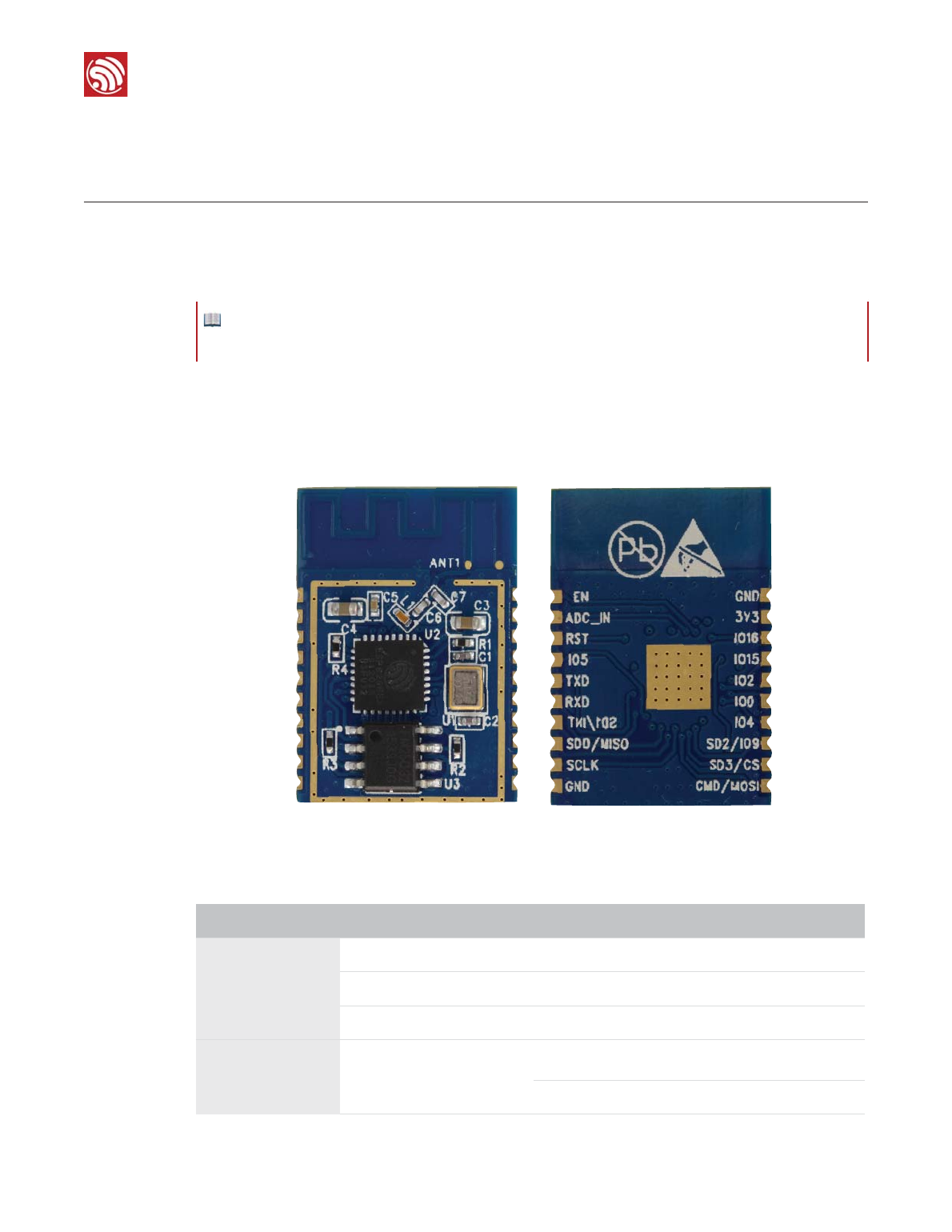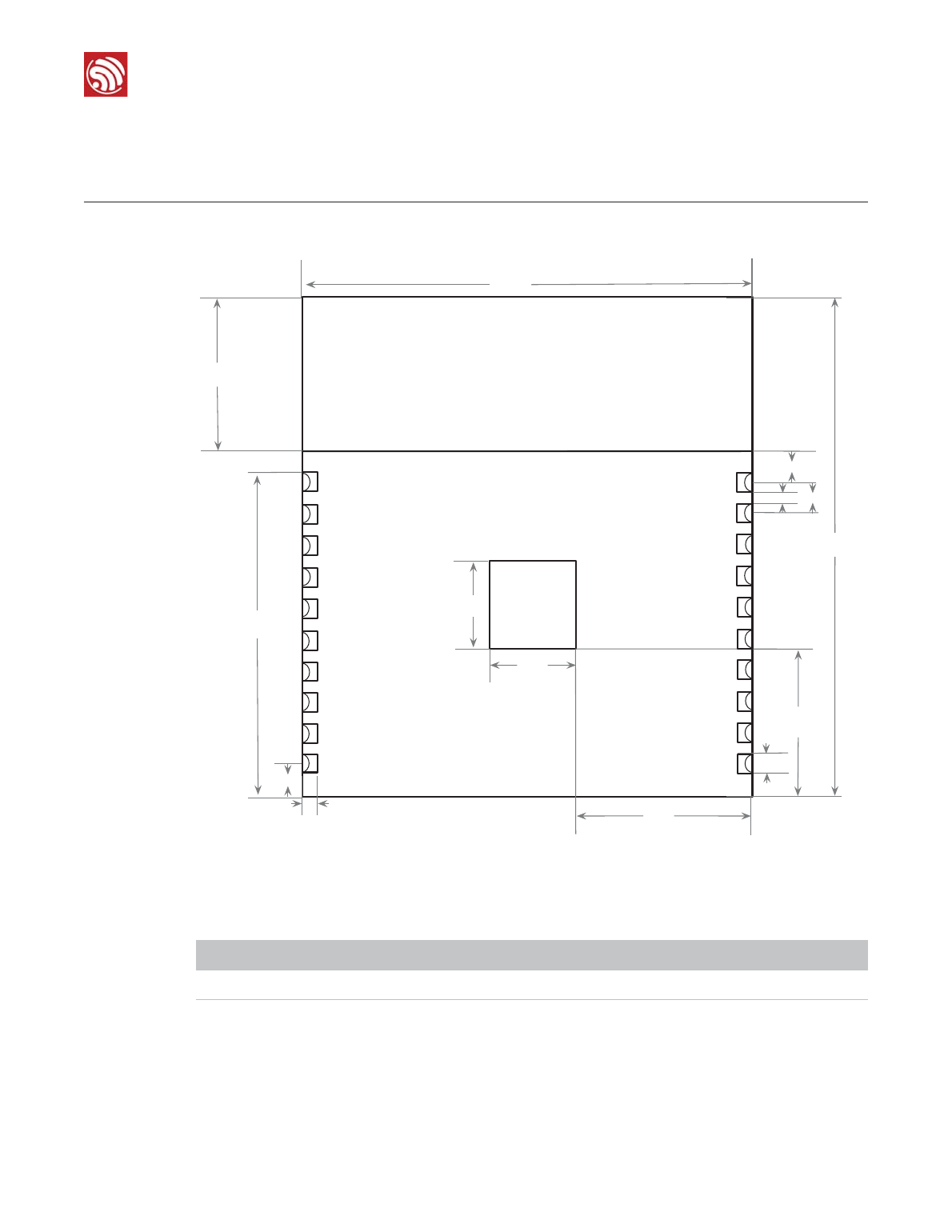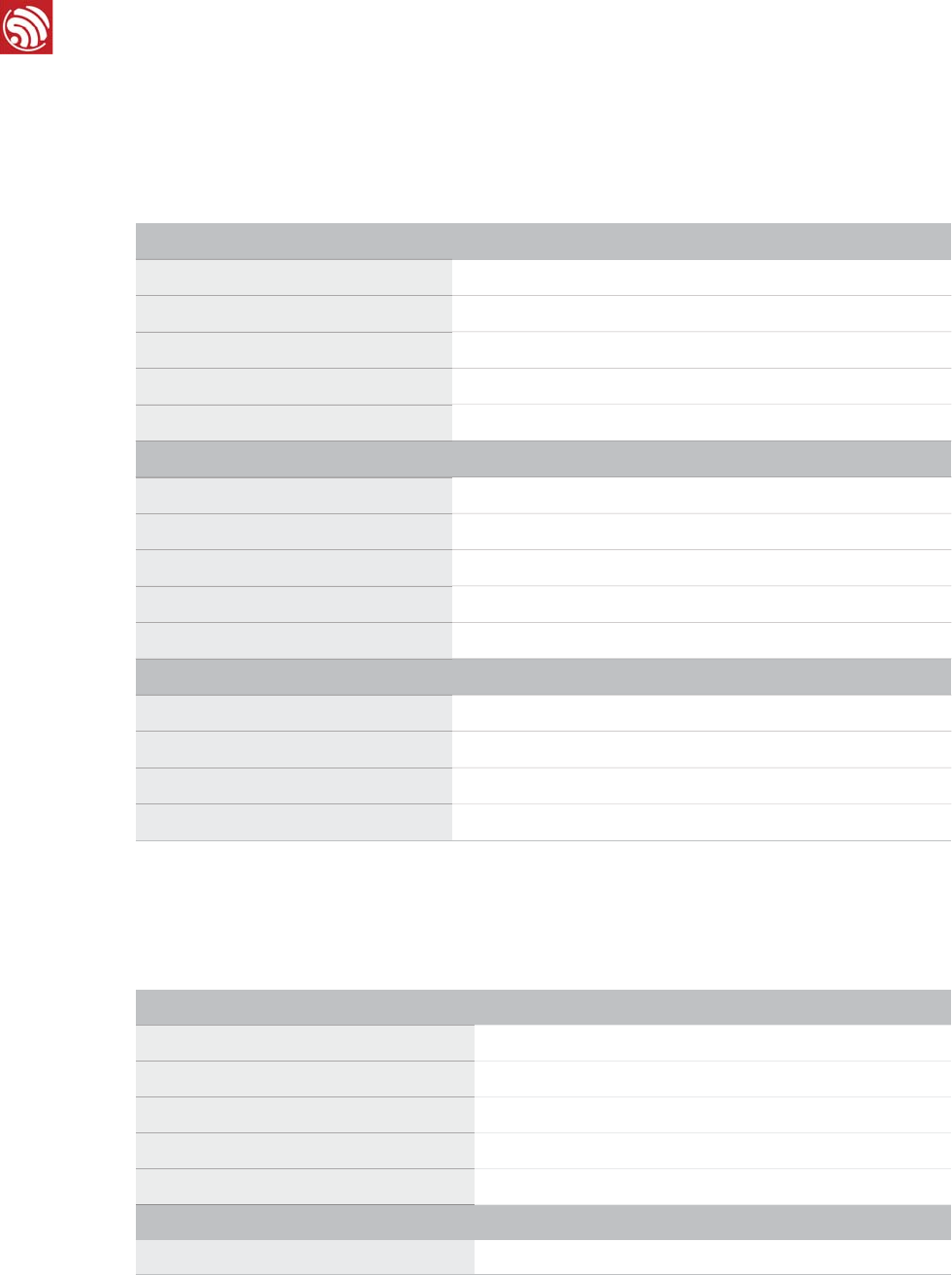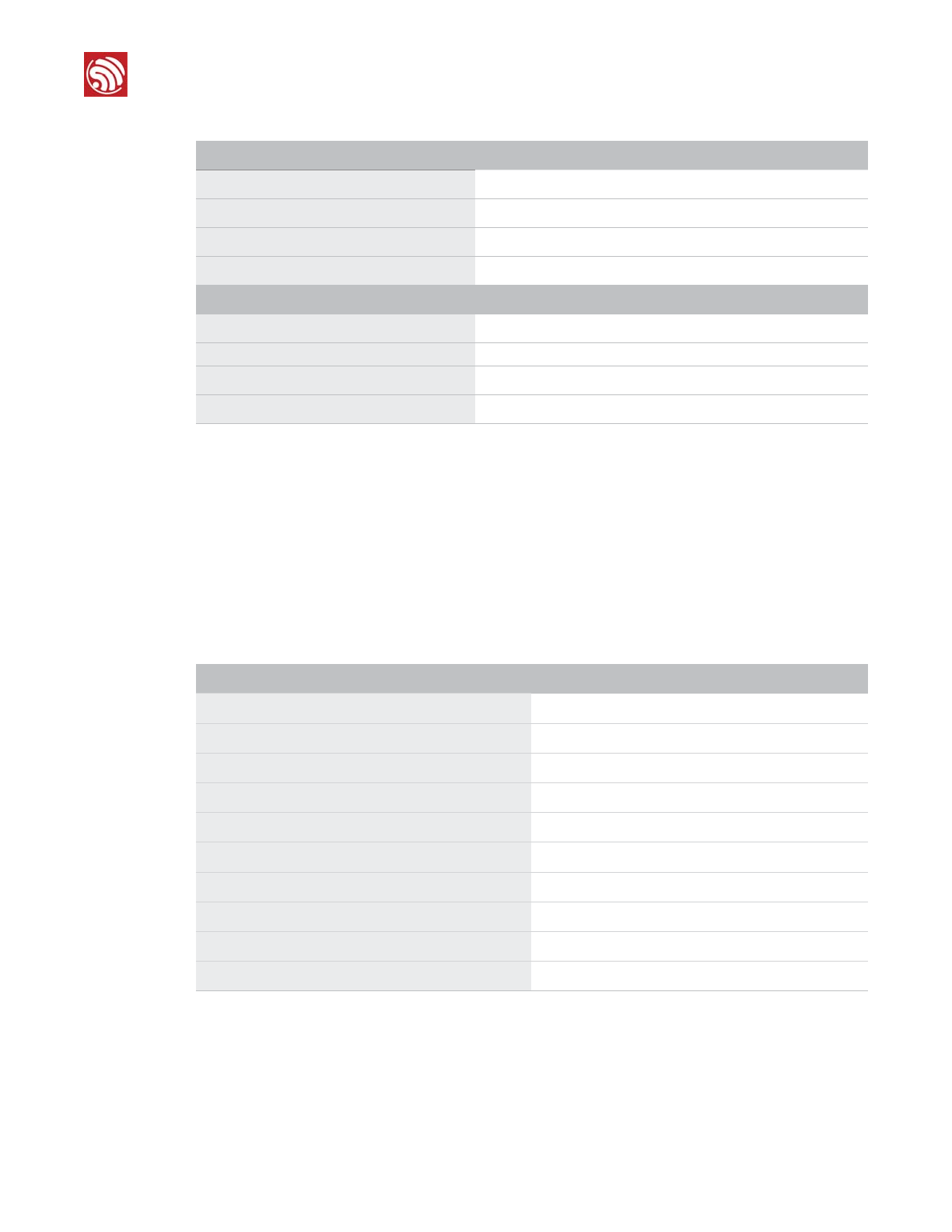ESPRESSIF SYSTEMS ESPWROOMS2 Wi-Fi Module User Manual ESP WROOM S2 Datasheet EN pages
ESPRESSIF SYSTEMS (SHANGHAI) PTE LTD Wi-Fi Module ESP WROOM S2 Datasheet EN pages
Users Manual

ESP-WROOM-S2
Datasheet
Version 1.1
Copyright © 2016

About This Guide
This document introduces users to the specifications of ESP-WROOM-S2 hardware,
including the following topics.
Release Notes
Chapter Title Subject
Chapter 1 Overview Introduction to ESP-WROOM-S2, including dimensions and
specifications.
Chapter 2 Pin Description Introduction to pin layout and the relevant description.
Chapter 3 Functional Description Description of the major functional modules and protocols applied on
ESP-WROOM-S2, including CPU, flash, memory and interfaces.
Chapter 4 Electrical Characteristics Electrical data of ESP-WROOM-S2.
Chapter 5 '$$8BSOJOH
Date Version Release notes
2016.06 V1.0 First release.
2016.08 V1.1
Updated the operating temperature range;
Added NCC Wi-Fi standard;
Updated Section 3.4 Interface Description.

Table of Contents
1. Overview1.................................................................................................................................
2. Pin Description3.......................................................................................................................
3. Functional Description5............................................................................................................
3.1. MCU5..........................................................................................................................................
3.2. Memory5......................................................................................................................................
3.2.1. Internal SRAM and ROM5.............................................................................................
3.2.2. SPI Flash5......................................................................................................................
3.3. Crystal Oscillator6.......................................................................................................................
3.4. Interface Description7.................................................................................................................
4. Electrical Characteristics8........................................................................................................
4.1. Absolute Maximum Ratings8.......................................................................................................
4.2. Recommended Operating Conditions8.......................................................................................
4.3. Digital Terminal Characteristics8.................................................................................................
4.4. RF Performance9.........................................................................................................................
4.5. Sensitivity9...................................................................................................................................
4.6. Power Consumption10................................................................................................................
4.7. Reflow Profile11...........................................................................................................................
5. '$$8BSOJOH.........................................................................................................................12

1. Overview
1. Overview
Espressif provides the SMD module - ESP-WROOM-S2 that integrates ESP8266EX. The
module has received various adjustments to achieve better RF performance. We
recommend using ESP-WROOM-S2 for tests or for further development.
The module size is 16 mm x 23 mm x 3 mm (see Figure 1-1). The flash used on this
module is a 2 MB SPI flash connected to HSPI, with the package size of SOP 8-150 mil.
The gain of the on-board PCB antenna is 2 dBi.
The ESP-WROOM-S2 works as the SDIO/SPI slave with the SPI speed of up to 8 Mbps.
Figure 1-1. ESP-WROOM-S2 Module
Note:
For more information on ESP8266EX, please refer to ESP8266EX Datasheet.
Table 1-1. ESP-WROOM-S2 Specifications
Categories Items Specifications
Wi-Fi
Standards FCC
Wi-Fi protocols 802.11 b/g/n
Frequency range 24M)[ ~ 24.)[
Peripheral interface
UART/I2C/GPIO/PWM/SDIO/SPI/IR Remote Control/
ADC
GPIO/PWM
Espressif /113 2016.08

1. Overview
Hardware
Operating voltage 3.0V ~ 3.6V
Operating current Average: 80 mA
Operating temperature range -40°C ~ 85°C
Storage temperature -40°C ~ 85°C
Package size 16 mm x 23 mm x 3 mm
External interface -
Software
Wi-Fi mode Station/SoftAP/SoftAP + Station
Security WPA/WPA2
Encryption WEP/TKIP/AES
Firmware upgrade UART Download / OTA (via network) / Download and
burn firmware via host
Software development Supports Cloud Server Development
SDK for secondary development
Network protocols IPv4, TCP/UDP/HTTP/FTP
User configuration AT Instruction Set, Cloud Server, Android/iOS App
Categories Items Specifications
Note:
ESP-WROOM-S2 with high temperature range option (-40°C ~ 125°C) is available for custom order.
Espressif /213 2016.08

2. Pin Description
2. Pin Description
Figure 2-1 shows the pin distribution of the SMD Module.
Figure 2-1. Top View of The ESP-WROOM-S2
ESP-WROOM-S2 has 20 pins, please see the pin definitions in Table 2-2.
1:GND
23.00
16.00
6.00
15.70
1.86
0.90
7.00
0.85
7.30
4.50
4.50
PCB ANTENNA
RST
IO5
TXD
RXD
GND
3V3
EN
IO16
IO15
IO0
IO4
IO2
SD2/IO9
GND
Unit: mm
SD3/CS
CMD/MOSI
SD1/INT
SD0/MISO
SCLK
ADC_IN
1.75
0.60 1.50
Table 2-1. ESP-WROOM-S2 Dimensions
Length Width Height PAD size (bottom) Pin Pitch
16 mm 23 mm 3 mm 0.9 mm x 0.85 mm 1.5 mm
Espressif /313 2016.08

2. Pin Description
Table 2-2. ESP-WROOM-S2 Pin Definitions
No. Pin Name Functional Description
1GND Ground
23V3
3.3 V power supply (VDD)
Note:
It is recommended the maximum output current a power supply provides be of
500 mA or above.
3IO16 GPIO16; used for Deep-sleep wake-up when connected to RST pin.
4IO15
HSPICS
•UART download: pull down.
•SDIO boot: floating (internal pull-up) or pull up.
5IO2
GPIO2; UART1_TXD
•UART download: pull down.
•SDIO boot: don’t-care.
6IO0
GPIO0
•UART download: pull down.
•SDIO boot: don’t-care.
7IO4 GPIO4
8SD2/IO9 SD_D2 (Series resistor: 100 ~ 200 Ω, 10 k pull-up resistor); GPIO9
9SD3/CS SD_D3 (Series resistor: 100 ~ 200 Ω, 10 k pull-up resistor); SLAVE_ SPI_CS
10 CMD/MOSI SD_CMD (Series resistor: 100 ~ 200 Ω, 10 k pull-up resistor); SLAVE_ SPI_MOSI
11 GND Ground
12 SCLK SD_CLK (Series resistor: 100 ~ 200 Ω); SLAVE_ SPI_CLK
13 SD0/MISO SD_D0 (Series resistor: 100 ~ 200 Ω, 10 k pull-up resistor); SLAVE_ SPI_MISO
14 SD1/INT SD_D1 (Series resistor: 100 ~ 200 Ω, 10 k pull-up resistor); SLAVE_ SPI_INT
15 RXD UART0_RXD, receive end in UART download;
GPIO3
16 TXD UART0_TXD, transmit end in UART download, floating (internal pull-up) or pull up;
GPIO1
17 IO5 GPIO5
18 RST Reset
19 ADC_IN Tests the power-supply voltage of VDD3P3 and the input power voltage of TOUT.
These two functions cannot be used simultaneously.
20 EN Chip enable pin (cannot be floating). Active high.
Espressif /413 2016.08

3. Functional Description
3. Functional Description
3.1. MCU
ESP8266EX contained in the ESP-WROOM-S2 integrates Tensilica L106 32-bit micro
controller (MCU) and a 16-bit RSIC. The CPU clock speed is 80 MHz and can reach a
maximum value of 160 MHz. The system can readily run a Real Time Operating System
(RTOS). Currently, the Wi-Fi stack only takes up 20% of CPU time. The remaining CPU time
(80% of total MIPS) can be used for user application. The MCU can work in conjunction
with the other parts of the chip through the following interfaces.
•Programmable RAM/ROM interface (iBus) that connects to memory controller and
can access the external flash.
•Data RAM interface (dBus) that connects to memory controller.
•AHB interface that accesses the register.
3.2. Memory
3.2.1. Internal SRAM and ROM
ESP8266EX Wi-Fi SoC integrates memory controller including SRAM and ROM. MCU can
access the memory controller through iBus, dBus, and AHB interfaces. All these interfaces
can access ROM or RAM units. A memory arbiter determines the running sequence in the
arrival order of requests.
According to our current version of SDK, SRAM space available to users is assigned as
below.
•RAM size < 50 kB, that is, when ESP8266EX is working in Station mode and
connects to the router, available space in Heap + Data sector is around 50 kB.
•There is no programmable ROM in ESP8266EX, therefore, user program must be
stored in the SPI flash integrated into the ESP-WROOM-S2.
3.2.2. SPI Flash
ESP8266EX supports SPI flash. Theoretically speaking, ESP8266EX can support up to 16
MB SPI flash.
ESP-WROOM-S2 currently integrates 2 MB SPI flash memory. ESP-WROOM-S2 supports
these SPI modes: Standard SPI, DIO (Dual I/O), DOUT (Dual Output), QIO (Quad I/O) and
QOUT (Quad Output).
Espressif /513 2016.08

3. Functional Description
3.3. Crystal Oscillator
ESP-WROOM-S2 uses 26 MHz crystal oscillator. The accuracy of the crystal oscillator
should be ±10 PPM, and the operating temperature range is -20°C to 85°C.
When using the download tool, please note to select the right crystal oscillator type. In
circuit design, capacitors C1 and C2 which connect to the earth, are added to the input
and output terminals of the crystal oscillator respectively. The values of the two capacitors
can be flexible, ranging from 6 pF to 22 pF, however, the specific capacitive values depend
on further testing and adjustment on the overall performance of the whole circuit. Normally,
the capacitive values of C1 and C2 are within 10 pF for the 26 MHz crystal oscillator.
Crystal oscillator should be placed as close to the XTAL pins as possible (without the traces
being too long). It is good practice to add high density ground vias around the clock trace
for great insulation.
There should be no vias on the input and output traces, which means the traces cannot
cross layers.
Place the input and output bypass capacitors on the near left or right side of the chip. Do
not place them on the traces.
Do not route high-frequency digital signal lines in the four-layer board. It is best not to route
any signal line under the crystal oscillator. The larger the copper area on the top layer is, the
better. As crystal oscillator is a sensitive component, do not place magnetic components
such as high current inductance nearby.
Notice:
Please use the most updated download tool and configure SPI MODE in the download tool as DIO or
DOUT.
Espressif /613 2016.08

3. Functional Description
3.4. Interface Description
Table 3-1. Interface Description
Interface Pin Functional Description
SPI GPIO12/13/14/15 or
GPIO6/7/8/11
S2 can control SPI Slave as a Master or communicate with Host MCU as
a Slave. In overlap mode, S2 can share the SPI interface with Flash,
shifted by different CS signals.
PWM Any available GPIO
(EXCEPT GPIO16)
Currently the demo provides 4 PWM channels (users can extend to 6
channels). PWM interface can realize the control of LED lights, buzzers,
relays, electronic machines, etc.
IR Any available GPIO
(EXCEPT GPIO16)
The functionality of infrared remote control interface can be realized via
software programming. The interface uses NEC coding, modulation, and
demodulation. The frequency of modulated carrier signal is 38 kHz.
ADC TOUT
Tests the power supply voltage of VDD3P3 (Pin 3 and Pin 4) and the input
power voltage of TOUT (Pin 6). However, these two functions cannot be
used simultaneously. This interface is typically used in sensors.
I2C Any available GPIO
(EXCEPT GPIO16) Connects to external sensors and display screens, etc.
UART
UART0:
TXD(U0TXD),
RXD(U0RXD)
UART1: IO2(TXD)
Communicates with UART device.
Downloading: U0TXD + U0RXD or GPIO2 + U0RXD
Communicating (UART0): U0TXD, U0RXD
Debugging: UART1_TXD (GPIO2) can be used to print debugging
information.
Espressif /713 2016.08

4. Electrical Characteristics
4. Electrical Characteristics
4.1. Absolute Maximum Ratings
4.2. Recommended Operating Conditions
4.3. Digital Terminal Characteristics
Note:
Unless otherwise specified, measurements are based on VDD = 3.3 V, TA = 25°C.
Table 4-1. Absolute Maximum Ratings
Rating Condition Value Unit
Storage temperatue - -40 ~ 125 ℃
Maximum soldering
temperature - 260 ℃
Supply voltage IPC/JEDEC J-STD-020 3.0 ~ 3.6 V
Table 4-2. Recommended Operating Conditions
Operating condition Symbol Min Typ Max Unit
Operating temperature - -40 20 125 ℃
Supply voltage VDD 3.0 3.3 3.6 V
Table 4-3. Digital Terminal Characteristics
Terminals Symbol Min Typ Max Unit
Input logic level low VIL -0.3 - 0.25 VDD V
Input logic level high VIH 0.75 VDD - VDD + 0.3 V
Output logic level low VOL N - 0.1 VDD V
Output logic level high VOH 0.8 VDD - N V
Espressif /813 2016.08

4. Electrical Characteristics
4.4. RF Performance
4.5. Sensitivity
Table 4-4. RF Performance
Description Min Typ Max Unit
Input frequency 2400 - 2483.5 MHz
Input impedance - 50 - ohm
Input reflection - - -10 dB
PA output power at 72.2 Mbps 15.5 16.5
17
dBm
PA output power in 11b mode 18 dBm
Sensitivity
CCK, 1 Mbps - -98 - dBm
CCK, 11 Mbps - -91 - dBm
6 Mbps (1/2 BPSK) - -93 - dBm
54 Mbps (3/4 64-QAM) - -75 - dBm
HT20, MCS7 (65 Mbps, 72.2 Mbps) - -72 - dBm
Adjacent channel rejection
OFDM, 6 Mbps - 37 - dB
OFDM, 54 Mbps - 21 - dB
HT20, MCS0 - 37 - dB
HT20, MCS7 - 20 - dB
Table 4-5. Sensitivity
Parameters Min Typ Max Unit
Input frequency 2412 - 24 MHz
Input impedance -50-Ω
Input reflection - - -10 dB
PA output power at 72.2 Mbps 15.5 16.5 17.5 dBm
PA output power in 11b mode dBm
Sensitivity
DSSS, 1 Mbps - -98 - dBm
Espressif /913 2016.08
16
17.5
16 17 18

4. Electrical Characteristics
4.6. Power Consumption
The following power consumption data were obtained from the tests with 3.3 V power
supply and a voltage stabilizer, in 25°C ambient temperature.
•All tests were performed at the antenna port without SAW filter.
•All data are based on 90% duty cycle in continuous transmission mode.
CCK, 11 Mbps - -91 - dBm
6 Mbps (1/2 BPSK) - -93 - dBm
54 Mbps (3/4 64-QAM) - -75 - dBm
HT20, MCS7 (65 Mbps, 72.2 Mbps) - -72 - dBm
Adjacent channel rejection
OFDM, 6 Mbps -37 -dB
OFDM, 54 Mbps -21 -dB
HT20, MCS0 -37 -dB
HT20, MCS7 -20 -dB
Parameters Min Typ Max Unit
Table 4-6. Power Consumption
Modes Min Typ Max Unit
Tx 802.11b, CCK 11 Mbps, POUT = +17 dBm - 170 - mA
Tx 802.11g, OFDM 54 Mbps, POUT = +15 dBm - 140 - mA
Tx 802.11n, MCS7, POUT = +13 dBm - 120 - mA
Rx 802.11b, 1024 bytes packet length , -80 dBm -50-mA
Rx 802.11g, 1024 bytes packet length , -70 dBm -56-mA
Rx 802.11n, 1024 bytes packet length , 65 dBm -56-mA
Modem-Sleep-15-mA
Light-Sleep- 0.9 - mA
Deep-Sleep-10-μA
Power Off- 0.5 - μA
Espressif /10 13 2016.08

4. Electrical Characteristics
4.7. Reflow Profile
Notes:
Modem-Sleep is used when applications require CPU to be working, such as PWM or I2S applications.
In the scenarios where Wi-Fi connectivity is maintained and data transmission is not required, Wi-Fi
Modem circuit can be shut down to save power, according to 802.11 standards (such as U-APSD). For
example, in DTIM3, when ESP8266EX sleeps for 300 ms and wakes up for 3 ms to receive Beacon
packages from AP, the overall average current consumption is about 15 mA.
Light-Sleep is used for applications whose CPU may be suspended, such as Wi-Fi switch. In the
scenarios where Wi-Fi connectivity is maintained and data transmission is not required, Wi-Fi Modem
circuit and CPU can be shut down to save power, according to 802.11 standards (such as U-APSD). For
example, in DTIM3, when ESP8266EX sleeps for 300 ms and wakes up for 3 ms to receive Beacon
packages from AP, the overall average current consumption is about 0.9 mA.
Deep-Sleep is for applications that do not require Wi-Fi connectivity and only transmit data with long time
lags, e.g., a temperature sensor that measures temperature every 100 s. For example, when ESP8266EX
sleeps for 300 s then wakes up to connect to AP (taking about 0.3 ~ 1 s), the overall average current
consumption is far less than 1 mA.
Table 4-7. Reflow Profile
Indicator Value
Ramp-up Rate (TS Max to TL)3℃/second max.
Preheat
Temperature Min. (TS Min.)
Temperature Typ. (TS Typ.)
Temperature Min. (TS Max.)
Time (TS)
150℃
175℃
200℃
60 ~ 180 seconds
Ramp-up Rate (TL to TP)3℃/second max.
Time maintained above: Temperature (TL)/Time (TL)217℃/60 ~ 150 seconds
Peak temperature (TP)260℃ max, for 10 seconds
Target Peak Temperature (TP Target) 260℃ + 0/-5℃
Time within 5°C of actual Peak Temperature (TP)20 ~ 40 seconds
TS max to TL (Ramp-down Rate) 6℃/second max.
Time 25°C to Peak Temperature (t) 8 minutes max.
Espressif /11 13 2016.08

5. Schematics
5. '$$8BSOJOH
Espressif /12 13 2016.08
ŶLJŚĂŶŐĞƐŽƌŵŽĚŝĨŝĐĂƚŝŽŶƐŶŽƚĞdžƉƌĞƐƐůLJĂƉƉƌŽǀĞĚďLJƚŚĞƉĂƌƚLJƌĞƐƉŽŶƐŝďůĞĨŽƌĐŽŵƉůŝĂŶĐĞĐŽƵůĚ
ǀŽŝĚƚŚĞƵƐĞƌΖƐĂƵƚŚŽƌŝƚLJƚŽŽƉĞƌĂƚĞƚŚĞĞƋƵŝƉŵĞŶƚ͘
This device complies with part 15 of the FCC Rules. Operation is subject to the following two conditions: (1)
This device may not cause harmful interference, and (2) this device must accept any interference received,
including interference that may cause undesired operation.
&>ĂďĞů/ŶƐƚƌƵĐƚŝŽŶƐ͗
dŚĞŽƵƚƐŝĚĞŽĨĨŝŶĂůƉƌŽĚƵĐƚƐƚŚĂƚĐŽŶƚĂŝŶƐƚŚŝƐŵŽĚƵůĞĚĞǀŝĐĞŵƵƐƚĚŝƐƉůĂLJĂůĂďĞůƌĞĨĞƌƌŝŶŐƚŽƚŚĞĞŶĐůŽƐĞĚ
ŵŽĚƵůĞ͘dŚŝƐĞdžƚĞƌŝŽƌůĂďĞůĐĂŶƵƐĞǁŽƌĚŝŶŐƐƵĐŚĂƐ͗͞ŽŶƚĂŝŶƐdƌĂŶƐŵŝƚƚĞƌDŽĚƵůĞ
FCC ID͗ϮϳͲ^WtZKKD^ϮΗŽƌ͞ŽŶƚĂŝŶƐFCC ID͗ϮϳͲ^WtZKKD^Ϯ͟ŶLJƐŝŵŝůĂƌǁŽƌĚŝŶŐƚŚĂƚĞdžƉƌĞƐƐĞƐƚŚĞ
ƐĂŵĞŵĞĂŶŝŶŐŵĂLJďĞƵƐĞĚ͘
&ZĂĚŝĂƚŝŽŶdžƉŽƐƵƌĞ^ƚĂƚĞŵĞŶƚ͗
dŽƐĂƚŝƐĨLJ&Z&džƉŽƐƵƌĞƌĞƋƵŝƌĞŵĞŶƚƐĨŽƌƚŚŝƐƚƌĂŶƐŵŝƐƐŝŽŶĚĞǀŝĐĞƐ͕ĂƐĞƉĂƌĂƚŝŽŶĚŝƐƚĂŶĐĞŽĨϮϬĐŵŽƌ
ŵŽƌĞƐŚŽƵůĚďĞŵĂŝŶƚĂŝŶĞĚďĞƚǁĞĞŶƚŚĞĂŶƚĞŶŶĂŽĨƚŚŝƐĚĞǀŝĐĞĂŶĚƉĞƌƐŽŶƐĚƵƌŝŶŐŽƉĞƌĂƚŝŽŶ͘dŽĞŶƐƵƌĞ
ĐŽŵƉůŝĂŶĐĞ͕ŽƉĞƌĂƚŝŽŶĂƚĐůŽƐĞƌƚŚĂŶƚŚŝƐĚŝƐƚĂŶĐĞŝƐŶŽƚƌĞĐŽŵŵĞŶĚĞĚ͘dŚĞĂŶƚĞŶŶĂ;ƐͿƵƐĞĚĨŽƌƚŚŝƐ
ƚƌĂŶƐŵŝƚƚĞƌŵƵƐƚŶŽƚďĞĐŽͲůŽĐĂƚĞĚŽƌŽƉĞƌĂƚŝŶŐŝŶĐŽŶũƵŶĐƚŝŽŶǁŝƚŚĂŶLJŽƚŚĞƌĂŶƚĞŶŶĂŽƌƚƌĂŶƐŵŝƚƚĞƌ͘

Disclaimer and Copyright Notice
Information in this document, including URL references, is subject to change without
notice.
THIS DOCUMENT IS PROVIDED AS IS WITH NO WARRANTIES WHATSOEVER,
INCLUDING ANY WARRANTY OF MERCHANTABILITY, NON-INFRINGEMENT, FITNESS
FOR ANY PARTICULAR PURPOSE, OR ANY WARRANTY OTHERWISE ARISING OUT
OF ANY PROPOSAL, SPECIFICATION OR SAMPLE.
All liability, including liability for infringement of any proprietary rights, relating to use of
information in this document is disclaimed. No licenses express or implied, by estoppel or
otherwise, to any intellectual property rights are granted herein.
The Wi-Fi Alliance Member logo is a trademark of the Wi-Fi Alliance. The Bluetooth logo is
a registered trademark of Bluetooth SIG.
All trade names, trademarks and registered trademarks mentioned in this document are
property of their respective owners, and are hereby acknowledged.
Copyright © 2016 Espressif Inc. All rights reserved.
Espressif IOT Team
www.espressif.com